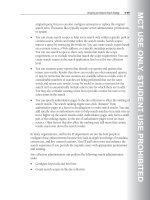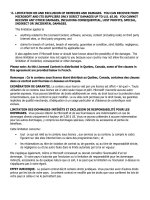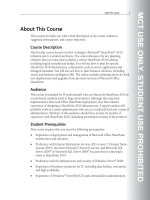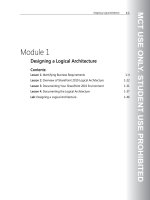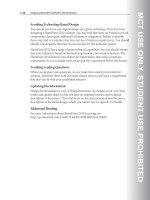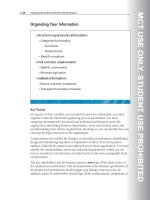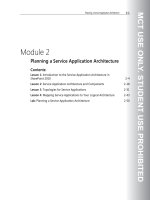Designing a Microsoft SharePoint 2010 Infrastructure Vol 1 part 2 doc
Bạn đang xem bản rút gọn của tài liệu. Xem và tải ngay bản đầy đủ của tài liệu tại đây (226.6 KB, 10 trang )
16. LIMITATION ON AND EXCLUSION OF REMEDIES AND DAMAGES. YOU CAN RECOVER FROM
MICROSOFT AND ITS SUPPLIERS ONLY DIRECT DAMAGES UP TO U.S. $5.00. YOU CANNOT
RECOVER ANY OTHER DAMAGES, INCLUDING CONSEQUENTIAL, LOST PROFITS, SPECIAL,
INDIRECT OR INCIDENTAL DAMAGES.
This limitation applies to
• anything related to the Licensed Content, software, services, content (including code) on third party
Internet sites, or third party programs; and
• claims for breach of contract, breach of warranty, guarantee or condition, strict liability, negligence,
or other tort to the extent permitted by applicable law.
It also applies even if Microsoft knew or should have known about the possibility of the damages. The
above limitation or exclusion may not apply to you because your country may not allow the exclusion or
limitation of incidental, consequential or other damages.
Please note: As this Licensed Content is distributed in Quebec, Canada, some of the clauses in
this agreement are provided below in French.
Remarque : Ce
le contenu sous licence étant distribué au Québec, Canada, certaines des clauses
dans ce contrat sont fournies ci-dessous en français.
EXONÉRATION DE GARANTIE. Le contenu sous licence visé par une licence est offert « tel quel ». Toute
utilisation de ce contenu sous licence est à votre seule risque et péril. Microsoft n’accorde aucune autre
garantie expresse. Vous pouvez bénéficier de droits additionnels en vertu du droit local sur la protection dues
consommateurs, que ce contrat ne peut modifier. La ou elles sont permises par le droit locale, les garanties
implicites de qualité marchande, d’adéquation à un usage particulier et d’absence de contrefaçon sont
exclues.
LIMITATION DES DOMMAGES-INTÉRÊTS ET EXCLUSION DE RESPONSABILITÉ POUR LES
DOMMAGES. Vous pouvez obtenir de Microsoft et de ses fournisseurs une indemnisation en cas de
dommages directs uniquement à hauteur de 5,00 $ US. Vous ne pouvez prétendre à aucune indemnisation
pour les autres dommages, y compris les dommages spéciaux, indirects ou accessoires et pertes de
bénéfices.
Cette limitation concerne:
• tout ce qui est relié au le contenu sous licence , aux services ou au contenu (y compris le code)
figurant sur des sites Internet tiers ou dans des programmes tiers ; et
• les réclamations au titre de violation de contrat ou de garantie, ou au titre de responsabilité stricte,
de négligence ou d’une autre faute dans la limite autorisée par la loi en vigueur.
Elle s’applique également, même si Microsoft connaissait ou devrait connaître l’éventualité d’un tel
dommage. Si votre pays n’autorise pas l’exclusion ou la limitation de responsabilité pour les dommages
indirects, accessoires ou de quelque nature que ce soit, il se peut que la limitation ou l’exclusion ci-dessus ne
s’appliquera pas à votre égard.
EFFET JURIDIQUE. Le présent contrat décrit certains droits juridiques. Vous pourriez avoir d’autres droits
prévus par les lois de votre pays. Le présent contrat ne modifie pas les droits que vous confèrent les lois de
votre pays si celles-ci ne le permettent pas.
Thank you for taking our training! We’ve worked together with our Microsoft Certified Partners
for Learning Solutions and our Microsoft IT Academies to bring you a world-class learning
experience—whether you’re a professional looking to advance your skills or a
student preparing for a career in IT.
n
Microsoft Certified Trainers and Instructors—Your instructor is a technical and
instructional expert who meets ongoing certification requirements. And, if instructors
are delivering training at one of our Certified Partners for Learning Solutions, they are
also evaluated throughout the year by students and by Microsoft.
n
Certification Exam Benefits—After training, consider taking a Microsoft Certification
exam. Microsoft Certifications validate your skills on Microsoft technologies and can help
differentiate you when finding a job or boosting your career. In fact, independent
research by IDC concluded that 75% of managers believe certifications are important to
team performance
1
. Ask your instructor about Microsoft Certification exam promotions
and discounts that may be available to you.
n
Customer Satisfaction Guarantee—Our Certified Partners for Learning Solutions offer
a satisfaction guarantee and we hold them accountable for it. At the end of class, please
complete an evaluation of today’s experience. We value your feedback!
We wish you a great learning experience and ongoing success in your career!
Sincerely,
Microsoft Learning
www.microsoft.com/learning
1
IDC, Value of Certification: Team Certification and Organizational Performance, November 2006
Welcome!
MCT USE ONLY. STUDENT USE PROHIBITED
iv Designing a Microsoft® SharePoint® 2010 Infrastructure
Acknowledgement
Microsoft Learning would like to acknowledge and thank the following for their
contribution towards developing this title. Their effort at various stages in the
development has ensured that you have a good classroom experience.
John Devaney – Content Developer
John is a Principle Technologist at CM Group and has worked in IT training and
content development for over 15 years. He has worked with collaboration
platforms and WCM since the mid-nineties and first worked on SharePoint with
SharePoint Portal Server 2003. He was part of the team who developed the
Microsoft Office SharePoint Server 2007 curriculum. In addition to content
development, John works as a consultant on a SharePoint and educational
development across a range of industries and technologies.
James Hamilton-Adams – Content Developer
James has been a trainer and consultant on Microsoft technologies for nearly 10
years, and is an associate technologist with CM Group. James specializes in
Microsoft Exchange Server, SharePoint Server, and Project Server, for which he
holds both MCTS and MCITP certifications. James has been working with
SharePoint since the first release in 2001, and regularly works with organizations
to assist with SharePoint integration into collaborative business processes.
Rose Malcolm – Content Developer
Rose is a Senior Technologist with CM Group and has been a trainer and writer on
Microsoft technologies for nearly 12 years. She has written technical
documentation, including security guides, whitepapers and e-Learning courseware,
along with several ILT courses for Microsoft Learning. Rose recently co-authored
the Microsoft Office SharePoint Server 2010 Hands-On Labs for the SharePoint
Product Group.
Steve Ryan – Content Developer
Steve is a Senior Technologist with CM Group. He is an MCITP Server
Administrator and a MCTS in Office SharePoint Server 2007, Active Directory,
Network Infrastructure, and Applications Infrastructure configuration. He has
authored several ILT courses for Microsoft Learning. He has also written technical
documentation, including security guides, whitepapers and e-Learning courseware.
He has authored the 'Administrator Accounts Security Planning', and 'Services and
Service Accounts Security Planning' guides for Microsoft. He co-authored the
Microsoft Office SharePoint Server 2010 Hands-On Labs for the SharePoint
MCT USE ONLY. STUDENT USE PROHIBITED
Designing a Microsoft® SharePoint® 2010 Infrastructure v
Product Group and also authored the 50213A - Implementing Data Protection
Manager 2007 ILT and e-Learning courses.
Scott Jamison - Subject Matter Expert
Scott Jamison (Microsoft Certified Master) is managing partner at Jornata LLC, a
Boston-based SharePoint consulting firm. He has over 20 years experience
designing and developing solutions using Microsoft technologies. Scott has
designed courseware for the SharePoint 2007 and 2010 Master Certifications and
is the author of several books, including Essential SharePoint 2007 and Essential
SharePoint 2010
Donal Conlon - Subject Matter Expert
Donal Conlon is a principal consultant at Jornata LLC, a Boston-based SharePoint
consulting firm. He has over 15 years experience designing and developing
solutions using Microsoft technologies. Donal has been working with SharePoint
for over 8 years and is a contributing author of Essential SharePoint 2010.
Peter Serzo – Technical Reviewer
Peter (MCP, MCPD, MCTS) has been consulting in technology for over 20 years.
Peter started his career working for Ross Perot's EDS programming in COBOL for
EDI and Electronic Commerce systems. He is currently a SharePoint Architect
consultant for Trillium Teamologies Inc. in Royal Oak, MI. His strength is in
understanding a myriad of business processes and melding them with a proper
SharePoint solution. With a major in English and a strong background in
mainframes to PCs, he brings a unique perspective to infrastructure and processes
that cannot be taught.
MCT USE ONLY. STUDENT USE PROHIBITED
vi Designing a Microsoft® SharePoint® 2010 Infrastructure
Contents
Module 1: Designing a Logical Architecture
Lesson 1: Identifying Business Requirements 1-4
Lesson 2: Overview of SharePoint 2010 Logical Architecture 1-22
Lesson 3: Documenting Your SharePoint 2010 Environment 1-31
Lesson 4: Documenting the Logical Architecture 1-37
Lab: Designing a Logical Architecture 1-46
Module 2: Planning a Service Application Architecture
Lesson 1: Introduction to the Service Application Architecture in
SharePoint 2010 2-4
Lesson 2: Service Application Architecture and Components 2-18
Lesson 3: Topologies for Service Applications 2-31
Lesson 4: Mapping Service Applications to Your Logical Architecture 2-43
Lab: Planning a Service Application Architecture 2-50
Module 3: Planning for Performance and Capacity
Lesson 1: Principles of Performance Planning 3-3
Lesson 2: Designing for Performance 3-17
Lesson 3: Principles of Capacity Planning 3-41
Lesson 4: Designing for Capacity 3-52
Lab: Planning for Performance and Capacity 3-65
Module 4: Designing a Physical Architecture
Lesson 1: Designing Physical Components for SharePoint Deployments 4-4
Lesson 2: Designing Supporting Components for SharePoint Deployments 4-20
Lesson 3: Topologies for Model Design 4-27
Lesson 4: Mapping a Logical Architecture Design to a Physical Architecture
Design 4-37
Lab: Designing a Physical Architecture 4-47
MCT USE ONLY. STUDENT USE PROHIBITED
Designing a Microsoft® SharePoint® 2010 Infrastructure vii
Module 5: Designing a Security Plan
Lesson 1: Designing Security for SharePoint 2010 5-3
Lesson 2: Planning for Service Accounts 5-8
Lesson 3: Planning for User and Group Security 5-18
Lesson 4: Planning for SSL 5-32
Lab: Designing a Security Plan 5-36
Module 6: Planning Authentication
Lesson 1: Overview of Authentication 6-3
Lesson 2: Introduction to Claims-Based Authentication 6-16
Lesson 3: Selecting Authentication Methods 6-25
Lab: Planning Authentication 6-36
Module 7: Planning Managed Metadata
Lesson 1: Metadata in SharePoint 2010 7-4
Lesson 2: Overview of Content Types 7-16
Lesson 3: Mapping Managed Metadata to Business Requirements 7-26
Lab: Planning Managed Metadata 7-36
Module 8: Planning Social Computing
Lesson 1: Overview of Social Computing 8-3
Lesson 2: Planning for Social Computing Functionality in SharePoint 2010 8-14
Lesson 3: Planning for the User Profile Service 8-37
Lab: Planning Social Computing 8-54
Module 9: Designing an Enterprise Search Strategy
Lesson 1: Overview of SharePoint 2010 Search Architecture 9-4
Lesson 2: Search Topologies in SharePoint 2010 9-19
Lesson 3: Capacity and Performance Planning for Search 9-28
Lesson 4: Mapping Business Requirements to Search Design 9-40
Lab: Designing an Enterprise Search Strategy 9-51
MCT USE ONLY. STUDENT USE PROHIBITED
viii Designing a Microsoft® SharePoint® 2010 Infrastructure
Module 10: Planning Enterprise Content Management
Lesson 1: Overview of Enterprise Content Management 10-4
Lesson 2: Planning Processes for Content Management 10-14
Lesson 3: Planning Features and Policies for Content Management 10-26
Lesson 4: Planning Web Content Management 10-46
Lab: Planning Enterprise Content Management 10-59
Module 11: Planning a SharePoint 2010 Implementation of a Business
Intelligence Strategy
Lesson 1: Overview of Business Intelligence Principles 11-4
Lesson 2: Planning Data Access Using BCS 11-14
Lesson 3: Planning SharePoint 2010 Business Intelligence Solutions 11-26
Lesson 4: Planning for Reporting and Presentation 11-44
Lab: Planning a SharePoint 2010 Implementation of a Business
Intelligence Strategy 11-51
Module 12: Developing a Plan for Governance
Lesson 1: Overview of Governance 12-4
Lesson 2: Key Elements of a Governance Plan 12-13
Lesson 3: Planning for Governance in SharePoint Server 2010 12-27
Lesson 4: Governance Implementation Features and Policies in SharePoint
Server 2010 12-38
Lab: Developing a Plan for Governance 12-51
Module 13: Designing a Maintenance and Monitoring Plan
Lesson 1: Principles of Maintenance and Monitoring 13-3
Lesson 2: Creating a Maintenance Plan for SharePoint 2010 13-11
Lesson 3: Creating a Monitoring Plan for SharePoint 2010 13-23
Lesson 4: Considerations for the Maintenance and Monitoring of
Associated Technologies 13-35
Lab: Designing a Maintenance and Monitoring Plan 13-46
MCT USE ONLY. STUDENT USE PROHIBITED
Designing a Microsoft® SharePoint® 2010 Infrastructure ix
Module 14: Planning Business Continuity
Lesson 1: Overview of Business Continuity Management 14-4
Lesson 2: Developing a Business Continuity Plan for SharePoint
Server 2010 14-15
Lesson 3: Creating a Backup and Restore Plan for SharePoint
Server 2010 14-34
Lab: Planning Business Continuity 14-47
Module 15: Planning for Upgrading to SharePoint 2010
Lesson 1: Identifying Upgrade Scenarios 15-4
Lesson 2: Planning Your Upgrade 15-23
Lesson 3: Upgrade Considerations 15-42
Lab: Planning for Upgrading to SharePoint 2010 15-57
Appendix: Lab Answer Keys
Module 1 Lab: Designing a Logical Architecture L1-1
Module 2 Lab: Planning a Service Application Architecture L2-1
Module 3 Lab: Planning for Performance and Capacity L3-1
Module 4 Lab: Designing a Physical Architecture L4-1
Module 5 Lab: Designing a Security Plan L5-1
Module 6 Lab: Planning Authentication L6-1
Module 7 Lab: Planning Managed Metadata L7-1
Module 8 Lab: Planning Social Computing L8-1
Module 9 Lab: Designing an Enterprise Search Strategy L9-1
Module 10 Lab: Planning Enterprise Content Management L10-1
Module 11 Lab: Planning a SharePoint 2010 Implementation of a
Business Intelligence Strategy L11-1
Module 12 Lab: Developing a Plan for Governance L12-1
Module 13 Lab: Designing a Maintenance and Monitoring Plan L13-1
Module 14 Lab: Planning Business Continuity L14-1
Module 15 Lab: Planning for Upgrading to SharePoint 2010 L15-1
MCT USE ONLY. STUDENT USE PROHIBITED
